The Economics and Statistics Division maintains archives of previous publications for accountability purposes, but makes no updates to keep these documents current with the latest data revisions from Statistics Canada. As a result, information in older documents may not be accurate. Please exercise caution when referring to older documents. For the latest information and historical data, please contact the individual listed to the right.
<--- Return to Archive
For additional information relating to this article, please contact:
March 01, 2024ALBERTA BUDGET 2024-25 The Province of Alberta has released its provincial budget for 2024-25.
After posting a forecasted surplus of $5.23 billion in 2023-24, Alberta anticipates its surplus will shrink to $367 million in 2024-25. The surplus is projected to expand to $1.44 billion in 2025-26 and to $2.64 billion in 2026-27.
Alberta's revenues are projected to contract by 2.8% in 2024-25 while expenditures grow by 3.9%. In 2025-26, Alberta's revenue growth is projected to accelerate to 3.4% while expenditure growth slows to 2.0%. For 2026-27, Alberta's revenue growth is projected to accelerate to 3.6% while expenditure growth edges up to 2.1%.
Alberta's revenue outlook depends on oil price assumptions. For each of the next three fiscal years, crude oil prices ($USD, WTI) are expected to remain stable at $74.00 per barrel. This results in falling revenues from bitumen resources.
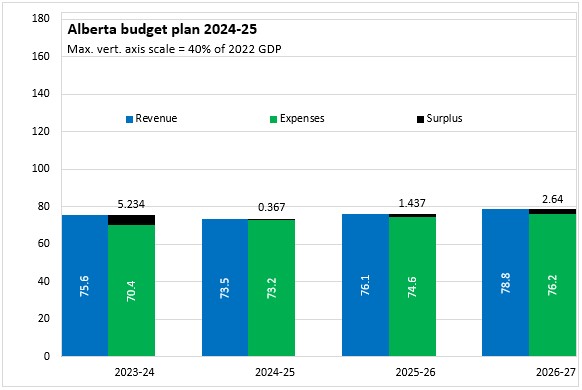
Measured as a share of GDP, the footprint of government in Alberta's economy is projected to be 16.1% in 2024-25. With nominal GDP growth projected to outpace revenue growth, the provincial government's revenues as a share of GDP are projected to contract to 15.4% by 2026-27. Alberta's surplus is projected to narrow from 1.2% of GDP forecasted for 2023-24 to 0.1% of GDP in 2024-25.
The Province of Alberta reports net financial assets estimated at 9.1% of GDP for 2024-25. This net asset position is projected to decline to 7.7% of GDP by 2026-27.
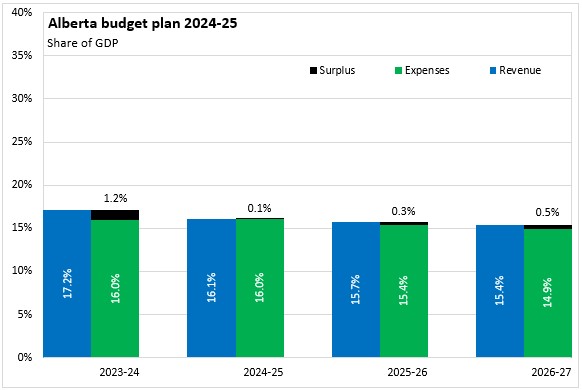
Alberta's government anticipates expenditures of $15,025 per capita in 2024-25 against revenues of $15,100 per capita. This creates a surplus of $75 per capita. In the next two fiscal years, expenditures per capita are projected to contract slightly while revenues per capita grow - expanding the surplus to $519 per capita by 2026-27.
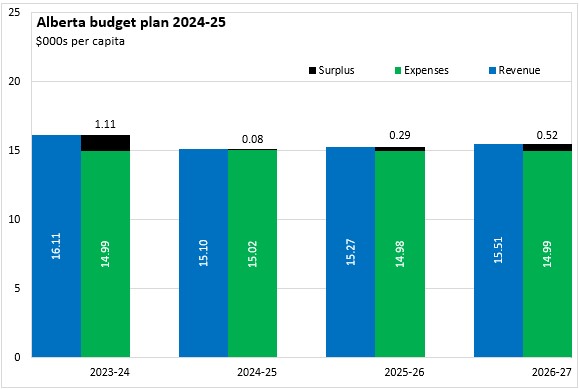
Compared with last year's fiscal outlook, Alberta is reporting higher revenues as well as higher expenditures.
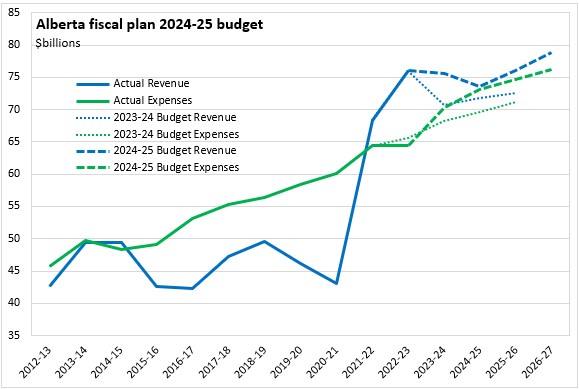
Alberta's projected surplus for 2024-25 is now smaller than previously-anticipated for this fiscal year. The projected surplus for 2025-26 is little changed from last year's outlook.
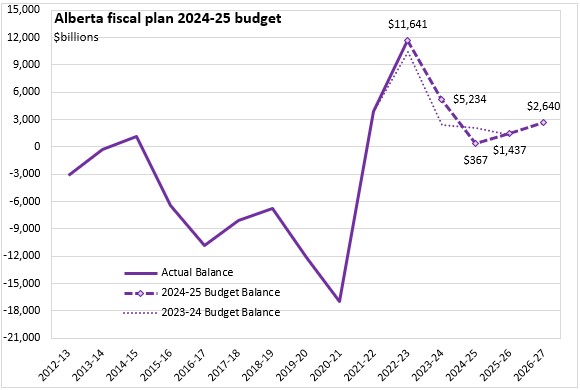
Alberta's economic growth is highly sensitive to activities in oil and gas industries, including exploration, development and production.
Despite high interest rates and global uncertainty, Alberta's economy is benefitting from rapid population growth as well as strong business investment intentions. Real GDP is projected to grow by 2.9% in 2024, accelerating to 3.3% in 2025. This outlook assumes that interest rates will ease in the second half of 2024, providing relief to consumers and businesses. Global economic recovery is expected to contribute to a rebound in external demand, as will expanding pipeline capacity expected in the coming years.
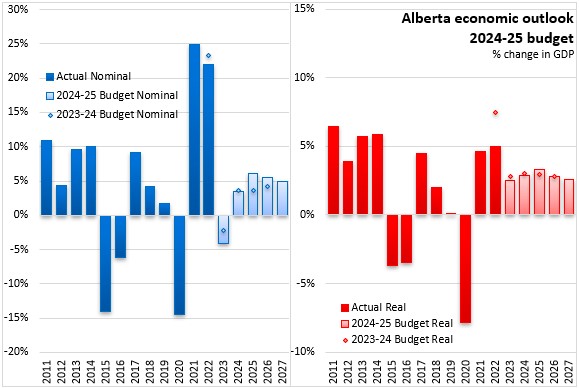
Key Measures and Initiatives
The Alberta Budget emphasizes a refocus for health care, supporting enrolment growth and meeting student needs, strengthening post-secondary education, supporting families, keeping life affordable and helping those in need. Key measures:
Improving health care service delivery
- $475 million for Modernizing Alberta’s Primary Health Care System: improved access to family physicians, primary care initiatives in Indigenous communities and a compensation model for nurse practitioners
- $300 million for collaborative primary health-care services
- $8 million (2 years) to expand the Alberta Newborn Screening Program
- $10 million to develop a midwifery strategy
- $20 million (2 years) to support women’s health initiatives
- $140 million per year for long-term care initiatives and home/community care initiatives
- $1 billion (3 years) to transform continuing care
- $1.55 billion for the Alberta Recovery Model for addictions or mental health challenges
Prioritizing patients to reduce wait times and improve access
- $810 million to advance the redevelopment and expansion of the Red Deer Regional Hospital, including Ambulatory Services
- $35 million to purchase new Emergency Medical Services vehicles and ambulances, upgrade the existing fleet and acquire additional equipment
- $25 million in additional funding for the Beaverlodge Municipal Hospital replacement project to support better access to health care for area residents
- $20 million over the next 3 years, including $17 million in new funding, to continue planning for a standalone Stollery Children’s Hospital
- $313 million for Alberta Surgical Initiative to help increase the number of surgical procedures performed in Alberta annually
- $2 billion per year for Drugs and Supplemental Health benefit programs, including $883 million for the seniors drug program that supports over 700,000 seniors
Health care workers
- $126 million (3 years) to increase rural and Indigenous access to medical education and to increase the number of family medicine physicians
- $6.6 billion for physician compensation and development programs
- $20 million per year to enhance physician practice viability
- $200 million (2 years) will improve access to family physicians and primary health care
- $26 million in capital funding (3 years) for the University of Lethbridge Rural Medical Teaching School
Supporting enrolment growth
- $1.9 billion in capital funding (3 years) for planning, design or construction of new and modernized schools
- $1.2 billion (3 years) to support enrolment growth and hire hundreds of new teachers
- $103 million (3 years) to increase modular classroom spaces
- $123 million (3 years) for collegiate school programs and public charter schools
- $24 million (3 years) to fund growth for new private schools
Meeting student needs
- $1.5 billion for learning supports funding for vulnerable students and children with specialized learning needs
- $209 million for timely and early education for children with severe developmental disabilities or delays
Strengthening post secondary programs
- $55 million (3 years) for the University of Calgary to add 1,000 spaces in science, technology, engineering and math programs
- $63 million for Olds College to renovate and expand student spaces
- $43 million for planning of NAIT’s trades and technology learning facility
- $62 million to create Rural Health Professional Training Centres and expand physician education
- $126 million (3 years) for the Rural Physician Expansion Program
- $43 million for the University of Lethbridge to train doctors in smaller communities
- $13 million to help businesses conduct applied research
- $102 million (3 years) to support 3,200 additional seats and curriculum updates for apprenticeship programs
- $10 million (3 years) to create additional mental health professional spaces
- $391 million for student aid and private career colleges support
- $72.6 million (3 years) for the Community Adult Learning Program and Foundational Learning Assistance Grants
Supporting strong families
- $1.5 billion to create more child-care spaces and lower fees
- $30 million to build small and mid-sized arenas, rinks, pools and sports fields
- $22 million (3 years) to index foster, kinship and other caregivers rates to inflation
Keeping life affordable
- $717 million (3 years) to advance Alberta’s Affordable Housing Strategy, including building 3,300 new affordable housing units as well as completing 1,800 units already underway
- $257 million for Seniors Lodge, Social Housing, Specialized Housing, Affordable Housing Strategy and Rental Assistance programs
- Rental assistance will be extended to another 550 households (total: 12,700 renter households)
- New 25% seniors discount for personal registry services and medical driving tests
Help for vulnerable persons
- $151 million in operating expense for Seniors, Community and Social Services
- $2.9 billion for the Assured Income for the Severely Handicapped (AISH) program, the Alberta Seniors Benefit and Income Support programs to cover indexing for inflation and caseload changes
- $355 million to cover indexation and population growth for payments under the Alberta Child and Family Benefit
- $70 million (3 years) to add new homeless shelter spaces and support operational cost pressures at shelters
- $85 million for the Prevention of Family and Sexual Violence program
- $15 million (3 years) to the implementation of Alberta’s Safe Streets Action Plan, as well as to support women’s shelters and sexual assault counselling centres
Alberta Budget 2024-25
<--- Return to Archive